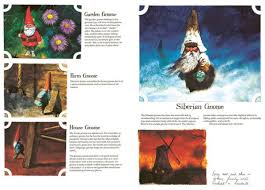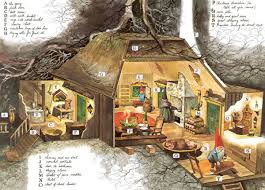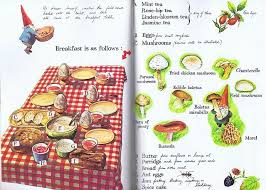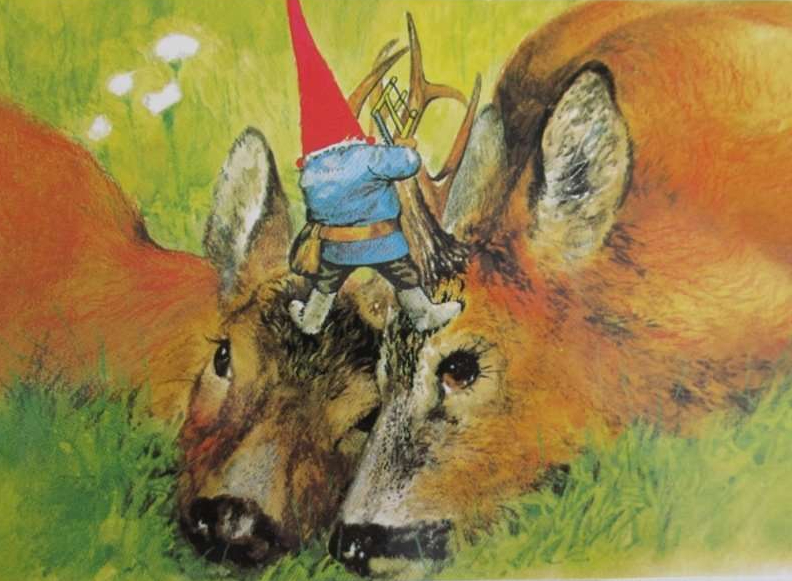

Image Credit: Rien Poortvliet
This part of my website will have information that goes for all (or most) gnomes.

Image Credit: Rien Poortvliet
- Woodland Gnomes: These gnomes live in the forest. The males wear a red hat, blue shirt, brown or dark green trousers, and a white beard. The females wear a green or grey hat, a cream shirt with red decorations, and a green skirt.
- Dune Gnomes: These gnomes live in deserts. The males of this variety wear orange caps and green shirts, while the females wear pale orange or pale green hats, khaki skirts and beige shirts embroidered with orange. They are slightly taller then forest gnomes.
- Garden Gnomes: They wear any colors, and live in gardens, preferably large ones.
- House Gnomes: They inhabit houses. Of all the gnomes, they know most about humankind. Wears any, preferably dark, clothes.
- Farm Gnomes: The male's clothes are, interestingly, quite similar to the dune gnomes. They have the same orange hat and green shirt for males, and all brown, red, or beige clothing for females. They're similiar to the house gnome in many ways.
- Siberian Gnomes: They are most affected by crossbreeding with trolls. Larger then other kinds of gnomes, perhaps about 18-21 centimeters tall. They wear brown clothing, usually, and they take horrible revenges for any offense, even a slight one.
Gnomes are almost entirely nocturnal. Short, careful trips in the day may be made if necessary, but the majority of the happenings of a gnome will be after sunset. They sleep in the day.
Gnomes have just two children, and no more, in their life. They are always twins. A long time ago, they had much larger families of up to 12 children (or in some cases, more), but at some point this immediately ceased due to reasons unknown to humans. Their lifespan is on average 400 years, with very few cases of living extremely long after, save a married couple in then Balkans who lived 550 years. They were looked after by a farming family who set out yoghurt for them. Gnome pregnancies are 12 months, and infancy lasts 12 years, reaching adulthood at 90.
Sometime after 400, gnomes will become forgetful and begin to wander. One night they will not return. According to gnomes, they have begun their journey to the "Mountain of Death," a mountain that gnomes go to. Not much more is known by us humans, and this "Mountain of Death" is likely a gnome's way of explaining that they simply die.
Gnome children are taught knowledge of whistles: how to blow them in different ways, what the noises mean, and how to tell them apart. They also learn knowledge of plants and animals, cooking and baking, and pottery, among other things - essentially how to live and prosper. When they're older, they will learn how to treat and heal other gnomes and animals.
Gnomes keep field mice as pets, such as us humans keep dogs or cats, which the children love to play with. They thouroughly enjoy swinging (adult gnomes also enjoy this, especially when they are pondering things) and use berries as balls, which they play a number of games with. Other games they enjoy are using maple seeds as "wings" and pretending to be dragonflies, flying kites, jump-rope, or throwing burs at each other.

Image Credit: Rien Poortvliet
Gnomes also build their own homes. Woodland, garden, and dune gnomes live underneath trees. With help from their fathers, and the local moles and rabbits (which are great friends of the gnomes) they burrow underneath trees (usually their birthday trees*, unless they have moved, which is extremely unlikely). They have several rooms, including the boot room (a sort of entryway), the living room, the kitchen, the dining room, the toilet room, and the bathroom. The dirt walls are stiff and packed, and insulated with fur, wool, or moss fiber.
*Birthday trees are trees that were planted on the day the gnome was born. By the time they're an adult, the tree will be large enough to dig under and house the gnome. They also can serve as a way to count one's age.
The boot room is the first room a gnome will make. There is a tunnel leading to it which has a polecat trap in it to protect the gnomes from predators such as rats, polecats, cats, small dogs or wolves, and other predatory animals small enough to fit through a gnome's doorway. The use of the room is quite self explanatory, it is where the gnomes keep their boots, skis, and other outside wear, and also the tools they use outdoors. The watch cricket (a gnome's version of a watch dog) is also kept here, and the bride's dowry chest, a beautiful wooden box, is in the corner.
The living room is next. It has comfortable chairs, and three little alcoves in the wall for bedrooms. One for the parents, one for the children, and one for guests. There are little doors in the walls that gnomes pull out in order to get into their bed.
Then there is the kitchen, which is very small. It has a little furnace and many cupboards. There is also the bathroom, which has a bath, a basin, and a cupboard full of anything a gnome could need while using this room. Then there is a toilet room. The door for this room is beautiful, ornately carved and a lovely brass colour, but the toilet inside is even more beautiful. It is of the same colour as the door, and even more beautifully carved, and inlaid with a manner of pretty rocks.
Finally, the dining room. There is a table, and chairs for the parents. The children have to stand during meals. Gnomes keep a candle on the table at all times. There is also cabinets that keep the utensils, plates, and bowls.
Gnomes are children until they are about 80. They begin thinking about marriage at around 100 years, which I can only assume is the equivelant of a 20-25 year old human. Once they find a gnome, they will present them with small gifts and other attentions. Courtship can last anywhere from 7 or 9 months to a year. If they return the attentions, they will soon get married. The house was finished years before, and is inspected by the in-laws beforehand.
Gnome weddings always occur beneath a full moon. Glowworms light the procession. After a small dinner, the newlywed couple will depart on their honeymoon, using birds such as wild geese or storks, otters, or foxes (in Siberia, wolves) as transportation. They visit surrounding areas (possibly checking in on friends who live far away). On these honeymoons, the newly married couple must visit the gnome palace once and pay respects to their rulers.
The couple is given the bride's dowry chest (kept in the boot room). It is wooden and beautifully carved and painted. Inside it are natural things, useful implements, and strange writings such as a poem, some odd sentences, or a proverb, all of these things gnomes delight in pondering over.
"To my amazement, I have heard that there are some people who have never seen a gnome. I cannot help pitying these people. I am certain there must be something wrong with their eyesight." - Axel Munthe
There have been several gnome sightings over time. Whether they are credible or not, we do not know. A Roman man by the name of Publius Octavus wrote in his journal in A.D. 470:
"Today I saw a miniature person with my own eyes. He wore a red cap and blue shirt. He had a white beard and green pants. He said that he had lived in this land for twenty years. He spoke our language, mixed with some strange words. Since then I have spoken with the little man many times. He said he was descended from a race called Kuwalden, a word unknown to us, and that there were only a few of them in the world. He liked to drink milk . Time and again I saw him cure sick animals in the meadows."
We can only assume that Octavus was lucky enough to see a gnome, specifically a woodland gnome, as they match his description perfectly.

Image Credit: Rien Poortvliet
I believe the next subject will be of great importance to one learning about gnomes. I will now tell you about a gnome's diet. They are vegetarian, with the exception of Siberian gnomes. Gnomes eat mushrooms, salads, infertile songbird eggs, ant eggs, berries and other fruit, nuts, and bread, generally, but you can learn the specific diets of the different varieties on their pages.
You can befriend gnomes by leaving milk out in the night, as they adore it. They also like alchohol, such as beer, mead, gin, and cider, also fermented raspberry wine.
Gnome parties are wonderful. They wear red embroidered tunics (or Bolero) and folk dancing slippers, and decorate their hats with berries, leaves, or flowers. They dance in circles, with much clapping and boot-slapping. The music is played on flutes, ocarinas, drums, fiddles, panpipes, and is accompanied by soft singing.
As for their language, they keep it a secret, although we know two words: te diews (thank you) and slizweitz (good night). Their written language is runes. They can also generally understand and decipher the noises an animal or bird makes.
Here is a list of words for "gnome" in many languages:
-Gnome (English, Irish)
-Gnom (Polish)
-Golach (Scottish)
-Kleinmanneken (Flemish)
-Kabouter (Dutch)
-Heinzelmannchen (German)
-Tomte (Norwegian)
-Nisse (Norwegian, Swedish, Danish)
-Tomtebisse (Swedish)
-Tonttu (Finnish)
-Domovoi Djedoesjka (Russian)
-Kippec (Serbo-Croatian)
-Patuljak (Serbo-Croatian)
-Djudje (Bulgarian)
-Skritek (Czechoslavakian)
-Mano (Hungarian)

Image Credit: Rien Poortvliet
Gnomes are naturally healers, and are considered an authority on what to do if an animal is injured. If, for example, two bucks were fighting and their antlers became entagled, a gnome would a help free them, or a deer sprain their ankle, a gnome would help heal it.
They also have a general knowledge of medicinal plants and their properties, and some basic tools, so that if some gnome or another were injured or ill, they could nurse them back to help. Serious injuries or illnesses are transported to the doctor at the royal court.
Their smell is far better than a human's. Their range of tastes - sweet, sour, salty, bitter, and savory - are, as far as we can tell, the same as ours. Their hair, especially beards, greys easily (young adulthood, 90-120 years on average). Due to their nocturnal habits, they have night vision, and their sight in the day may be affected for some time if they venture outside.
Gnomes have a strange knowledge of weather, and can predict the next day's weather with accuracy, despite their lack of human technology. When asked how they know, they immediately become evasive, and mumble about "old know-how" and "feeling it in their bones."
Height-wise, gnomes do not differ greatly from each other, and the adult is 6-7 inches tall, with some 5 inch fellows. The only exception is the Siberian gnome (as usual) being a good 20 or so centimeters on average.
"A gnome without a cap is not a gnome, and he knows it." - Wil Huygen
One of the most well-known things about a gnome, is, of course, their pointed cap. After all, they are never seen without it. As a baby, gnomes are given said hat, and do not take it off, save to bathe or to sleep. If it is beyond repair or lost, they will fashion a new one, and not leave their house until it is finished. Small wear and tear, though, will be quickly remedied by sewing or adding new layers of felt. It is quite embarrassing to be seen without your hat in public, and they would rather go without pants than without cap. It is made of stiff felt. Unmarried female gnomes will let their braids stick out of their hat, but after marriage, they will disappear beneath a scarf and a hat.
On the subject of clothing, their shoes, in warm weather, will be acorn clogs or soft bark shoes. In winter, or a cold climate, they will opt for deer (or, if there is none to spare, chipmunk, squirrel, rabbit, etc.) leather-and-fur boots. All their shoes have a careful birds-foot shape in them, causing their footprints to look like a bird's. They also tend to step on moss, leaves, pebbles, or pine needles, to avoid leaving a trail.